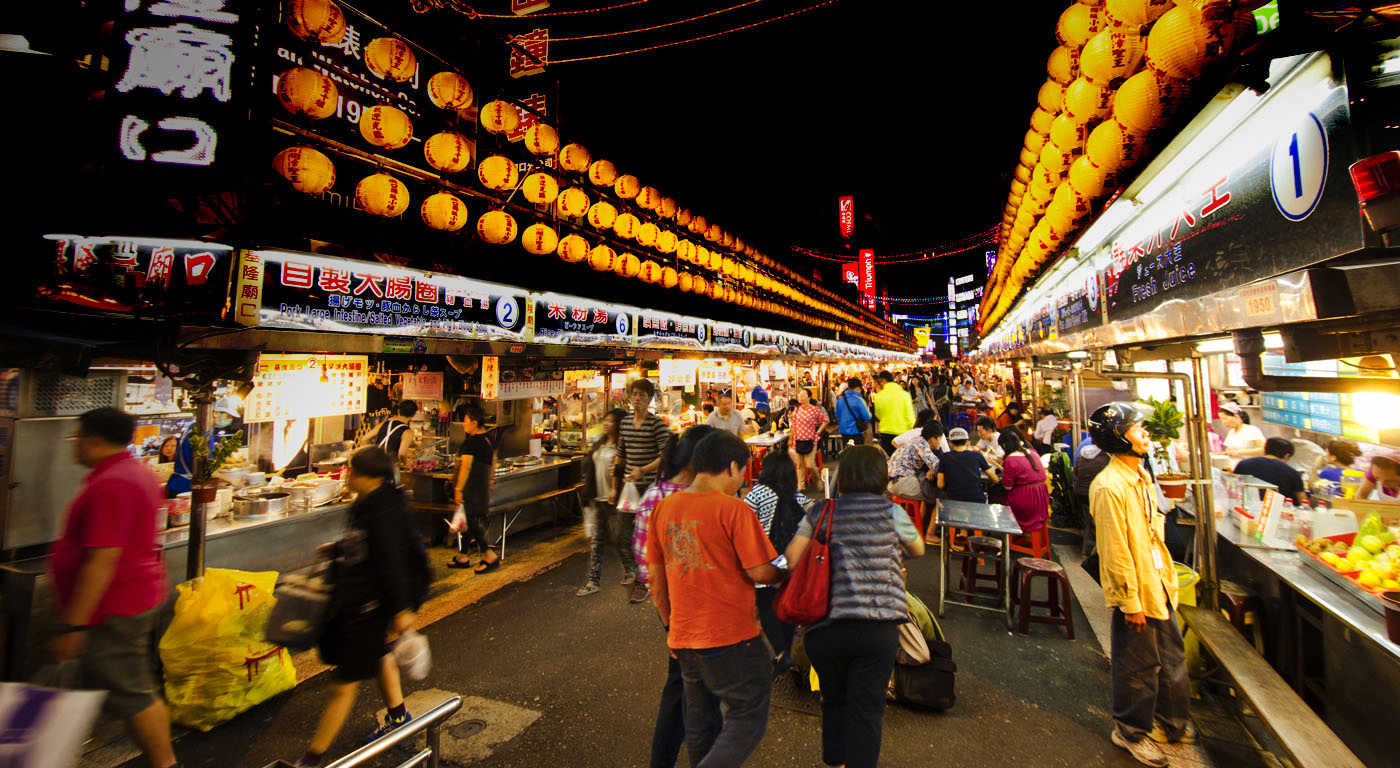
The renowned food market in Keelung has been founded for more than 40 years. It surrounds Dianji Temple on Ren 2nd Road in Keelung. It is located on Ren 3rd Road between Ai 2nd Road and Ai 3rd Road. There are many kinds of eatery here and more than 200 food stands gather in the area of 400 meters. When walking in the food market, one would wish that he (she) had an unlimited appetite to taste all of the delicious foods here. The owner of each food stand strives to create delicacy.Good materials are used for the dishes and prices are modest. The market attracts huge crowd each day. The famous dishes include soup mix, fried fish pastry, meat soup, fried oysters and meat on rice, etc. There are seafood, fried chicken, cold desserts, and more. Visiting the food market will give you a chance to taste all of the famous dishes in Taiwan. Other than local residents, many tourists visit the place for a good bite. Please do visit the food market in Keelung for Taiwans delicacy.The food market in Keelung is open until late at night, about 2:00 am or 3:00am. You can see many food stands spreading smell of tasty foods at this hour. Nearby there are also stands for clothes and daily items. One can go for some shopping after a good meal.
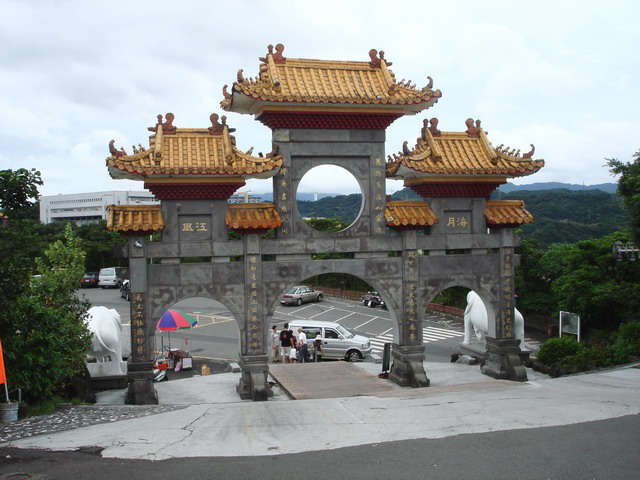
Zhongzheng (Jhongjheng) Park is situated on the side of Dashawan Mountain, which is at the east of Keelung City. There is a white statue of Goddess of Mercy in the park. This 25-meter high statue has become one of the characteristics of Keelung.The park overlooks Keelung City and the harbor. There are three levels in the park. On the first level is a historic canon fort. On the second level is a Buddhist library, Martyrs Shrine and Zhuputan Temple. The temple attracts many worshipers on July 15. On the third level is Guanhai Pavilion. Sitting in the pavilion, visitors can see the entire Keelung and the ocean.The statue of Goddess of Mercy is the landmark of Zhongzheng (Jhongjheng) Park. It is the biggest Goddess statue in Southeast Asia. Inside the statue is a stairway leading to the top. Zhuputan is where worshipers gather on Zhongyuan Festival. The first immigrants to Taiwan used to fight with each other for land. In order to stop the disputes, they set up a temple for yearly worship. The temple was in Gaosha Park during the Japanese occupation and moved to Zhongzheng (Jhongjheng) Park.
The Port of Keelung also seen as Keelung Harbor, is located in the vicinity of Keelung City, Taiwan. It is operated by Taiwan International Ports Corporation, the Taiwans only state-owned harbor management company.
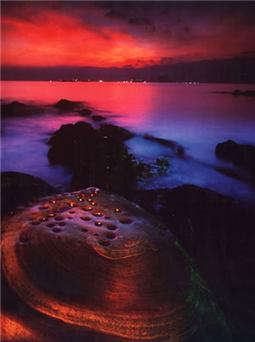
Keelung Islet stands northeast off Keelung. It is the most prominent island landmark in northern Taiwan and is the guidepost for ships shuttling in and out of Keelung Harbor. The graceful parabolic contour of the island makes it one of the eight scenic spots of Keelung.Keelung Islet is a beautiful volcanic island surrounded by cliffs, and there is almost no plain on it. Walks and pavilions are the main recreational facilities on the island. Along the wooden walks, various plants indigenous to Taiwan will unfold before the eyes of visitors, displaying the beauty of nature. For instance, Formosa lily blossoms will cover the entire island in the spring.The island presents multiple beauties in accordance with climatic changes. The entire volcanic island is visible to the eyes during cloudless weather but displays a glimmering look at dusk.Visitors of Keelung Islet can take a scenic boat tour from Bisha Fishing Harbor in the summer, which will enable them to watch the spectacular landscape of the island along the cruise.
Heping Island was called Sheliao Island in the past. It is located at the north of Taiwan. Heping Bridge connects the island to Keelung City. In 1626, the Spanish army built castles, churches and fortresses, preparing to do business with China and Japan. The castle on the southwest is called San Salvador, the saint savior. This is the first and currently the only castle in Keelung. During the Spanish occupation, Heping Island had busy trading activities with Southeast Asia. After World War II, the island was renamed Heping Island. Today, it is a famous tourist attraction.Heping Island is perfect for diving and sea fishing. With years of erosion by the wind and sea, the eroded rocks and coasts have formed special shapes. The Keelung government has made Heping Island a coastal park with swimming pool, tour track, tourism service center and food and beverages.
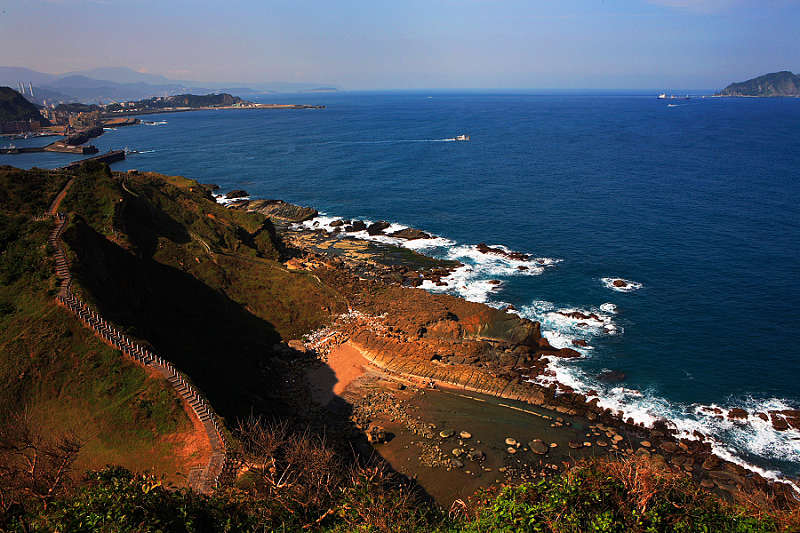
Badouzi is located southeast of Heping Island, which was originally an isolated island but became more like a peninsula after a power plant was built on the island. This has made the famous Wangyou Valley and Badouzi Coastal Park more accessible than it was before.The Badouzi Fishing Port was established in 1975 and is the largest fishing port in northern Taiwan. The village next to the port, where the gelidium amansii sea weed and fishing huts are seen everywhere, is a well-known fish-processing workshop in Taiwan. The marine harvests processed here include squids, silver anchovies, big-eye herrings, and flying-fish spawn.The Wangyou Valley, located between Badouzi and Changtan Neighborhood, is covered all over by grasses which form a graceful contour. Walking down the steps to the valley, with the Badouzi Fishing Port and Keelung Island in sight, visitors will leave their worries all behind.From the top of the cliffs, there is a trail that will lead visitors down to a beach beneath. Wave-cut platforms and bean curd rocks form the sandy and rocky landscape of the beach, which is a suitable place for collecting seashells, catching crabs and playing with water.Visitors will be able to reach the hilltop and overlook the deep blue sea by following the road round the hill. When the night falls, the lights of fishing boats and the lamps along the coastal highway will make a splendid night scene. Looking back, visitors will see the mountainous town of Jiufen(Jioufen) brightened up by twinkling lights.
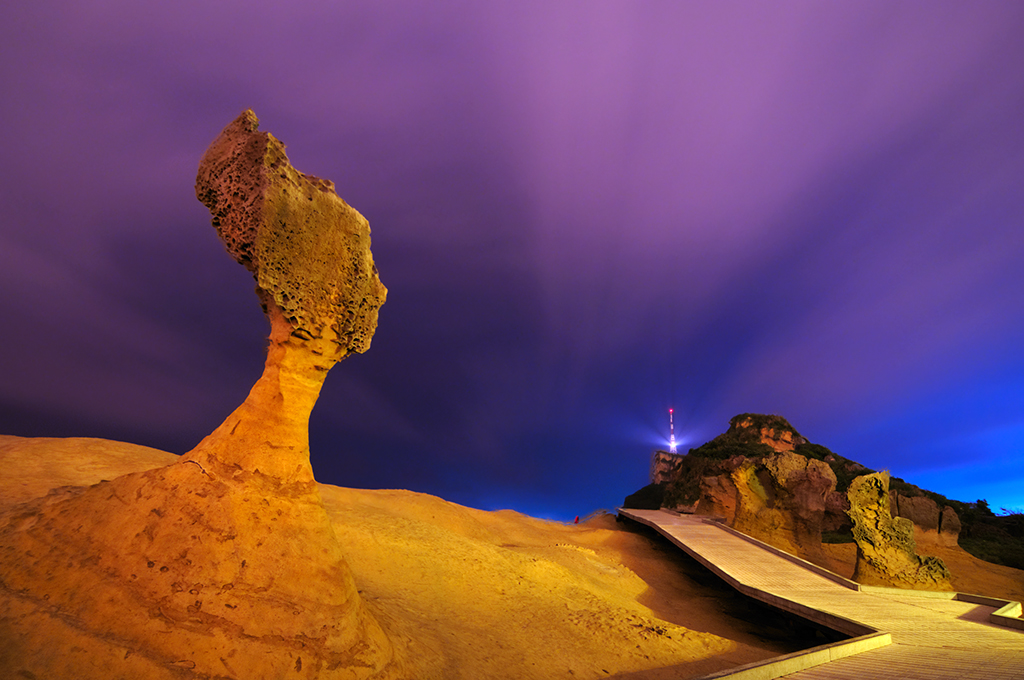
Yeliu (Yeliou) is a cape of about 1,700 meters long formed by Datun Mountain reaching into the sea. When overlooked from above, the place is like a giant turtle submerging into the sea. Thus, it is also called "Yeliu (Yeliou) Turtle". Because the rock layer of seashore contains sandstone of limestone texture and it is subject to sea erosion, weathering and earth movements, there is particular scenery consisting of sea trenches/holes, candle shaped rocks, and pot shaped rocks. The place is divided into three sections. The first section has rocks like Queens Head, Fairys Shoe and Candle. The second section has rocks like Bean Curd, Dragon Head. The third section has sea-eroded caves, seal shaped rock, etc. The place is suitable for geological study and field research. In addition, there is a statue of Lin Tien Jane in commemoration of the persons bravery of scarifying own live for saving others. The monument describes in details the touching story. There is a marine world in Yeliu. The marine world is the first marine center in the country for exhibition of ocean evolution. It has the best sightseeing tunnel under sea, showing about 200 rare fish species and marine lives. The area of marine live specimen demonstrates many specimens of precious marine mammals and fish. It is very educational. There are excellent shows of whales, dolphins and seals, such as diving, ballet on water and other talent shows. There is a stadium with 3,500 seats. On holidays, the place attracts many visitors for the show. When you visit Yeliu, dont forget to visit sea world and feel the marine wanders.
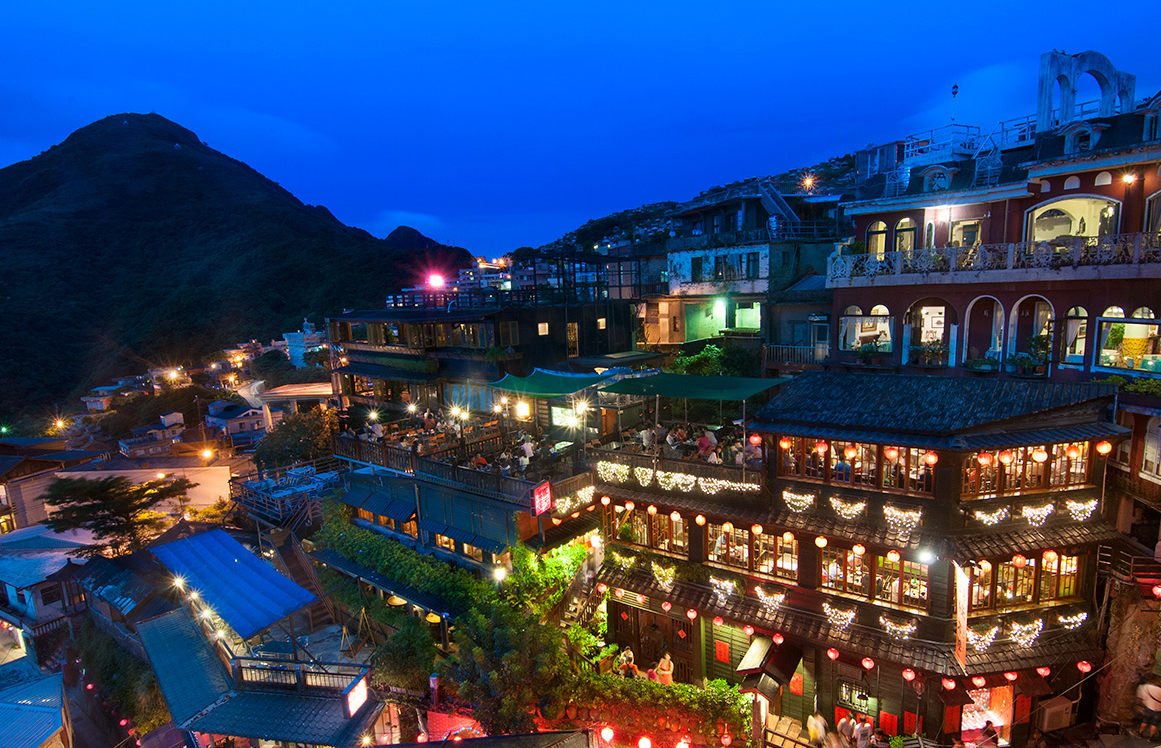
It is said that long time ago there were only nine families in Jiufen (Jioufen). Before the roads on land were built, all materials were transported via ships. Thus a habit was formed that nine pieces of same object were purchased at one time for reservation. Hence, the place was called Jiufen (Jioufen).Jiufen (Jioufen) used to be the center of gold mining. It is located within the hills in northeast of Taiwan. The village is next to the mountain and facing the sea. In 1890, someone struck gold near Jiufen (Jioufen). The poor village with only nine families soon attracted prospectors of 4,000 families. The village once was gold city of Asia and called little Shanghai or little Hong Kong. However, with the decline of gold mining activities, Jiufen (Jioufen) fades. Later, several movies chose to shoot here and the movies won international acknowledgement. For example, the film the Sad City has won first prize in Venice Film Festival and awakened peoples memory of Jiufen (Jioufen). It seems that the prosperous old streets, buildings, mines and the glamorous gold digging days are flashing before our eyes. The place is whispering its golden past. Now, there are many unique teahouses in Jiufen (Jioufen). These teahouses are best stops during visit to this mountain village. Also, there is the beautiful ocean view of Keelung outer sea.The most prosperous shopping district is Jiufen (Jioufen) Old Street. It goes through most of the village. There are many visitors on the street. Along the street there are shops vending the most famous country snack of Jiufen (Jioufen), yam dish and various local dishes. There are some historical items well reserved. The trip to Jiufen (Jioufen) is full of fun and delights. Jiufen (Jioufen) has many accommodation places provided by local residents. If you were not in a hurry, you may want to pick a nice inn and stay for the starlight and fishing lights at night.
Ping River (Pingsi) and Shifen are just two of several towns alongside highway 106, a narrow back road that runs between southern Taipei and southern Keeling. Ping River (Pingsi) Heavenly Lantern Festival is one of the three most popular and well-known celebration event during the Lantern Festival. Since 1999, the Taipei County Government has devoted substantial resources to promote this festival, in a bid to promote it to become an international and multi-ethnic culture exchange activity. Through this festival, presenting the Heavenly Lantern tradition and the natural beauty of Ping River (Pingsi) to the public and prayers to the heavenly God and wishing for prosperity and peace for the nation and its citizens.
Qingan Temple is also known as Mazu Temple, built in the 1980s at Keelung harbor. The temple lies on the left side of Zhong 2nd Road of Keelung City and is one of the oldest temples in Keelung. In the early times Keelung is a massive import and export commercial harbor, most of the people work in the fishery industry and the temple enshrines the Mazu Goddess to pray for safety. The temple was moved to its current location due to the land reclamation, but the architecture was carefully preserved during the process; the quaint ambience, the exquisite dragon sculpture, the simple yet vigorous stone lions, the tile outer wall and the stone inner wall all makes the whole architecture exquisite and refined. The ghost festival in Lunar July and the Mazu Birthday in March are both huge annual events for the temple.